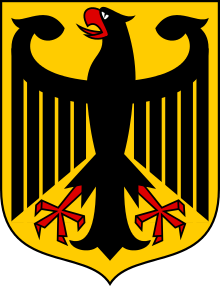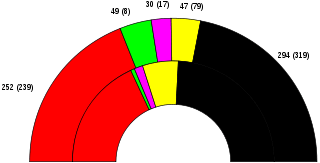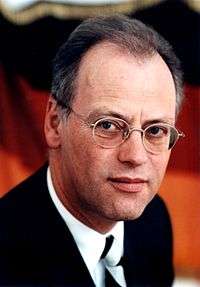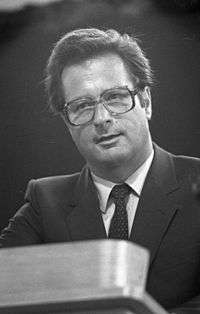1994 German federal election
Federal elections were held in Germany on 16 October 1994 to elect the members of the 13th Bundestag. The CDU/CSU alliance led by Helmut Kohl remained the largest faction in parliament, with Kohl remaining Chancellor. This elected Bundestag was largest in history until 2017, numbering 672 members.
| ||||||||||||||||||||||||||||||||||||||||||||||||||||||||||||||||||||||||||||||||||
All 672 seats in the Bundestag 337 seats needed for a majority | ||||||||||||||||||||||||||||||||||||||||||||||||||||||||||||||||||||||||||||||||||
|---|---|---|---|---|---|---|---|---|---|---|---|---|---|---|---|---|---|---|---|---|---|---|---|---|---|---|---|---|---|---|---|---|---|---|---|---|---|---|---|---|---|---|---|---|---|---|---|---|---|---|---|---|---|---|---|---|---|---|---|---|---|---|---|---|---|---|---|---|---|---|---|---|---|---|---|---|---|---|---|---|---|---|
| Registered | 60,452,009 | |||||||||||||||||||||||||||||||||||||||||||||||||||||||||||||||||||||||||||||||||
| Turnout | 47,737,999 (79.0%)[1] | |||||||||||||||||||||||||||||||||||||||||||||||||||||||||||||||||||||||||||||||||
| ||||||||||||||||||||||||||||||||||||||||||||||||||||||||||||||||||||||||||||||||||
 Results by state for the second votes. Light blue denotes states where the CDU/CSU won a plurality of votes; darker blue denotes states where CDU/CSU won an absolute majority of votes; pink denotes states where the SPD won a plurality of votes. | ||||||||||||||||||||||||||||||||||||||||||||||||||||||||||||||||||||||||||||||||||
| ||||||||||||||||||||||||||||||||||||||||||||||||||||||||||||||||||||||||||||||||||
Issues and campaign
The SPD let its members elect a candidate for Chancellor against Helmut Kohl. Rudolf Scharping, Minister-President of Rhineland-Palatinate, beat Gerhard Schröder and Heidemarie Wieczorek-Zeul in the SPD's internal election. Tension between Scharping and other SPD leaders such as Oskar Lafontaine and Gerhard Schröder hampered his campaign.
For the first time in their existence, the Greens seemed to be willing to actually join a government in the event that a centre-left SPD-Grünen coalition had a workable majority in the Bundestag.
Results
 |
|---|
| This article is part of a series on the politics and government of Germany |
|
|
Head of State |
|
Executive
|
|
|
Administrative divisions
|
|
| Parties | Constituency | Party list | Total seats | |||||||||||||
|---|---|---|---|---|---|---|---|---|---|---|---|---|---|---|---|---|
| Votes | % | +/− | Seats | +/− | Votes | % | +/− | Seats | +/− | Seats | +/− | % | ||||
| Social Democratic Party (SPD) | 17,966,813 | 38.3 | +3.1 | 103 | +12 | 17,140,354 | 36.4 | +2.9 | 149 | +1 | 252 | +13 | 37.5 | |||
| Christian Democratic Union (CDU) | 17,473,325 | 37.2 | −1.1 | 177 | −15 | 16,089,960 | 34.2 | −2.5 | 67 | −9 | 244 | −24 | 36.3 | |||
| Christian Social Union (CSU) | 3,657,627 | 7.8 | +0.4 | 44 | +1 | 3,427,196 | 7.3 | +0.2 | 6 | −2 | 50 | −1 | 7.4 | |||
| Alliance '90/The Greens† | 3,037,902 | 6.5 | +0.9 | 0 | ±0 | 3,424,315 | 7.3 | +2.3 | 49 | +41 | 49 | +41 | 7.3 | |||
| Free Democratic Party (FDP) | 1,558,185 | 3.3 | −4.5 | 0 | −1 | 3,258,407 | 6.9 | −4.1 | 47 | −31 | 47 | −32 | 7.0 | |||
| Party of Democratic Socialism (PDS) | 1,920,420 | 4.1 | +1.8 | 4 | +3 | 2,066,176 | 4.4 | +2.0 | 26 | +10 | 30 | +13 | 4.5 | |||
| The Republicans (REP) | 787,757 | 1.7 | ±0 | 0 | ±0 | 875,239 | 1.9 | −0.2 | 0 | ±0 | 0 | ±0 | 0 | |||
| The Grays – Gray Panthers (GRAUE) | 178,450 | 0.4 | −0.1 | 0 | ±0 | 238,642 | 0.5 | −0.3 | 0 | ±0 | 0 | ±0 | 0 | |||
| Ecological Democratic Party (ÖDP) | 200,138 | 0.4 | −0.1 | 0 | ±0 | 183,715 | 0.4 | ±0 | 0 | ±0 | 0 | ±0 | 0 | |||
| Natural Law Party (Naturgesetz) | 59,087 | 0.1 | +0.1 | 0 | ±0 | 73,193 | 0.2 | +0.2 | 0 | ±0 | 0 | ±0 | 0 | |||
| Animal Protection Party | – | – | – | – | – | 71,643 | 0.2 | +0.2 | 0 | ±0 | 0 | ±0 | 0 | |||
| Party of Bible-abiding Christians (PBC) | 26,864 | 0.1 | +0.1 | 0 | ±0 | 65,651 | 0.1 | +0.1 | 0 | ±0 | 0 | ±0 | 0 | |||
| Statt Party (STATT) | 7,927 | 0.0 | +0.0 | 0 | ±0 | 63,354 | 0.1 | +0.1 | 0 | ±0 | 0 | ±0 | 0 | |||
| Bavaria Party (BP) | 3,324 | 0.0 | ±0 | 0 | ±0 | 42,491 | 0.1 | ±0 | 0 | ±0 | 0 | ±0 | 0 | |||
| Car-drivers' and Citizens' Interests Party (APD) | 1,654 | 0.0 | +0.0 | 0 | ±0 | 21,533 | 0.0 | +0.0 | 0 | ±0 | 0 | ±0 | 0 | |||
| Christian Centre (CM) | 3,559 | 0.0 | ±0 | 0 | ±0 | 19,887 | 0.0 | −0.1 | 0 | ±0 | 0 | ±0 | 0 | |||
| Party of the Willing to Work and Socially Vulnerable (PASS) | 489 | 0.0 | +0.0 | 0 | ±0 | 15,040 | 0.0 | +0.0 | 0 | ±0 | 0 | ±0 | 0 | |||
| Marxist-Leninist Party of Germany (MLPD) | 4,932 | 0.0 | +0.0 | 0 | ±0 | 10,038 | 0.0 | +0.0 | 0 | ±0 | 0 | ±0 | 0 | |||
| Solidarity (BüSo) | 8,032 | 0.0 | +0.0 | 0 | ±0 | 8,103 | 0.0 | +0.0 | 0 | ±0 | 0 | ±0 | 0 | |||
| Christian League (Liga) | 3,788 | 0.0 | ±0 | 0 | ±0 | 5,195 | 0.0 | −0.1 | 0 | ±0 | 0 | ±0 | 0 | |||
| Centre Party (Zentrum) | 1,489 | 0.0 | +0.0 | 0 | ±0 | 3,757 | 0.0 | +0.0 | 0 | ±0 | 0 | ±0 | 0 | |||
| Federation of Socialist Workers (BSA) | – | – | – | – | – | 1,285 | 0.0 | ±0 | 0 | ±0 | 0 | ±0 | 0 | |||
| Free Citizens' Union (FBU) | 8,193 | 0.0 | +0.0 | 0 | ±0 | – | – | – | – | – | 0 | ±0 | 0 | |||
| German Social Union (DSU) | 2,395 | 0.0 | −0.3 | 0 | ±0 | – | – | – | – | – | 0 | ±0 | 0 | |||
| German Communist Party (DKP) | 693 | 0.0 | +0.0 | 0 | ±0 | – | – | – | – | – | 0 | ±0 | 0 | |||
| DVP | 606 | 0.0 | +0.0 | 0 | ±0 | – | – | – | – | – | 0 | ±0 | 0 | |||
| Free Social Union (FSU) | 467 | 0.0 | +0.0 | 0 | ±0 | – | – | – | – | – | 0 | ±0 | 0 | |||
| Communist Party of Germany (KPD) | 426 | 0.0 | +0.0 | 0 | ±0 | – | – | – | – | – | 0 | ±0 | 0 | |||
| Independent Workers' Party (UAP) | 302 | 0.0 | +0.0 | 0 | ±0 | – | – | – | – | – | 0 | ±0 | 0 | |||
| Liberal Democrats (LD) | 221 | 0.0 | +0.0 | 0 | ±0 | – | – | – | – | – | 0 | ±0 | 0 | |||
| Federation for a Complete Germany (BGD) | 107 | 0.0 | +0.0 | 0 | ±0 | – | – | – | – | – | 0 | ±0 | 0 | |||
| Democrats (DEMOKRATEN) | 104 | 0.0 | +0.0 | 0 | ±0 | – | – | – | – | – | 0 | ±0 | 0 | |||
| Electoral groups and independents | 34,080 | 0.1 | ±0 | 0 | ±0 | – | – | – | – | – | 0 | ±0 | 0 | |||
| Invalid/blank votes | 788,643 | — | — | — | — | 632,825 | — | — | — | — | — | — | — | |||
| Totals | 47,737,999 | 100 | ±0.0 | 328 | ±0 | 47,737,999 | 100 | ±0.0 | 344 | +10 | 672 | +10 | ±0 | |||
| Registered voters/turnout | 60,452,009 | 79.0 | — | — | — | 60,452,009 | 79.0 | — | — | — | — | — | — | |||
| Source: Federal Returning Officer | ||||||||||||||||
- ^† — totals for the Greens reflect the merger of the Western and Eastern Green parties.

| 294 | 47 | 252 | 49 | 30 |
| CDU/CSU | FDP | SPD | Grüne | PDS |
Post-election
The coalition between the CDU/CSU and the FDP was able to continue in power with Helmut Kohl as chancellor.
The PDS won four constituency seats in its power base of the former East Berlin, qualifying it for proportional representation even though the party won 4.4 percent of the vote, just short of the 5% electoral threshold required for full parliamentary status. Under a longstanding electoral law intended to benefit regional parties, any party that wins at least three constituency seats is entitled to its share of proportionally-elected seats, regardless of vote share.[2]
This was the first time in the history of the Federal Republic that the FDP was not the third largest party in the chamber.
References
- "Voter turnout by election year". Website of the Federal Returning Officer's Office. The Federal Returning Officer. Archived from the original on 7 November 2014. Retrieved 7 November 2014.
- Dan Hough; Michael Koß; Jonathan Olsen (2007). The Left Party in Contemporary German Politics. Springer. ISBN 0230592147.
_cropped.tif.jpg)


